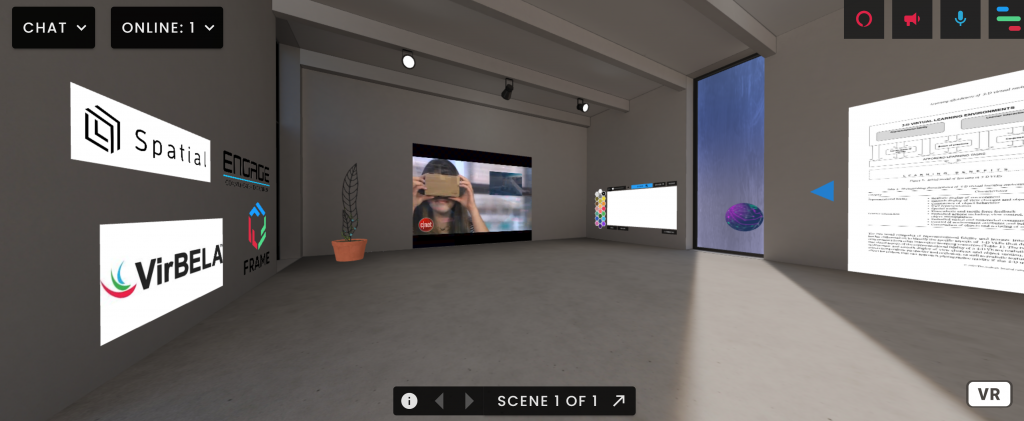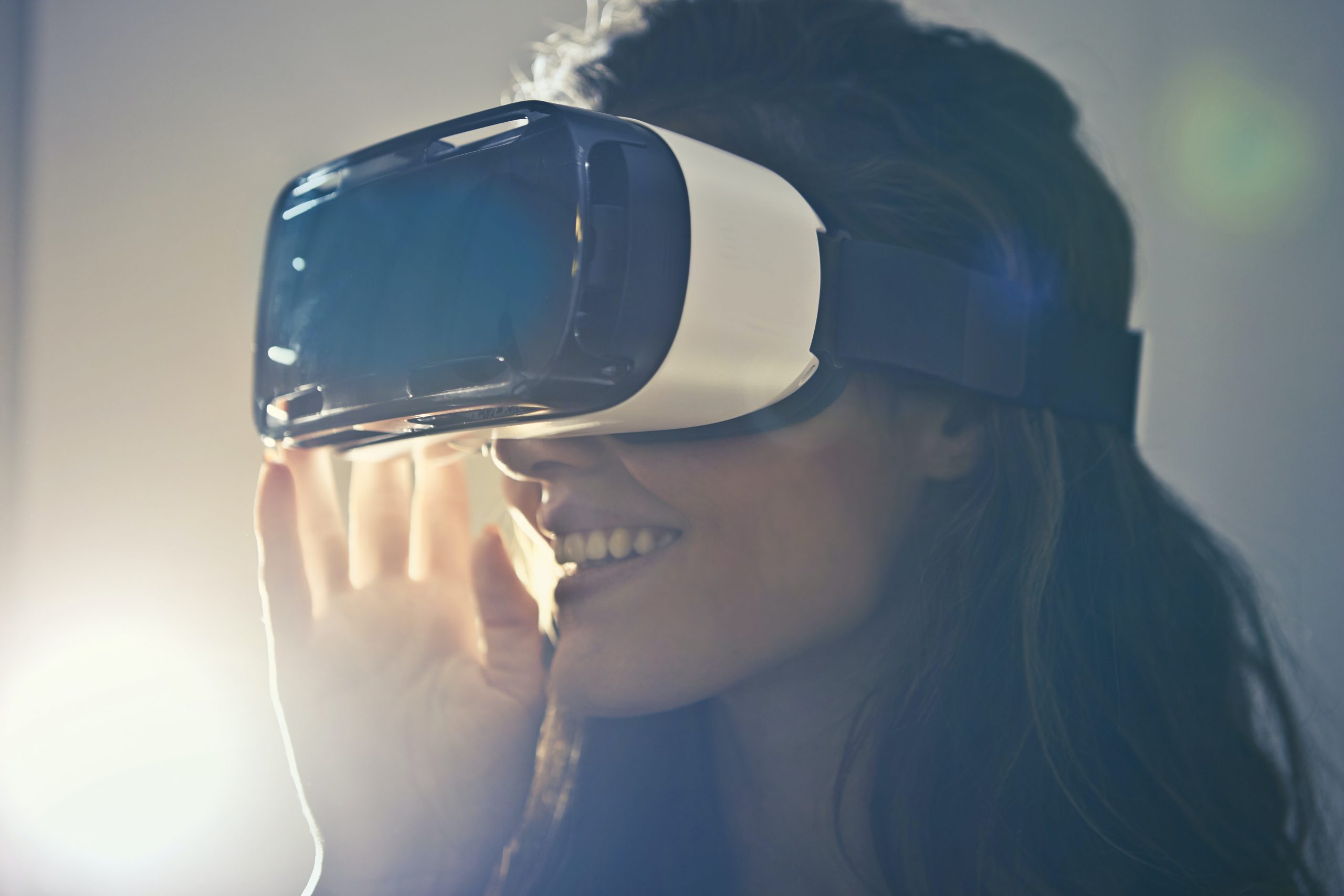
Some may believe there are no future in affordances between Virtual Reality and Mobile Devices, however I believe this union is a future prospect to develop accessibility and engagement in Education. I’m not referring to the Google Cardboard to make mobile devices Virtual Reality headsets, which brought Virtual Reality to mobile affordances years ago and has since died off. Rather the opposite, where mobile affordances allow for integration into cooperative Virtual Reality environments on the go. In the past year, there have been several companies seeking to bridge the gap to increase mobile affordances and connection into virtual worlds for those who are unable to immerse themselves using a VR headset.

To explore my research and prediction of a transformation of educational practices, step into my virtual space created in FrameVR.io, accessible on your desktop, mobile device, or VR headset. You will become an avatar in the space and can explore my research, interact with 360 photospheres and whiteboard, and watch my video. You may even run into some classmates!
Please note: If you are interacting on a mobile device, I would suggest keeping your screen vertical.
Integrated VR and Mobile Experiences:
Engage VR
FRAME VR
Spatial VR
Virbela
References
A. Kanamgotov, A. Christopoulos, M. Conrad, & S. Prakoonwit. (2012). Immersion in virtual worlds – but not second life! Paper presented at the – 2012 International Conference on Cyberworlds, 107-113. https://doi.org/10.1109/CW.2012.22
Baños, R. M., Botella, C., Rubió, I., Quero, S., García-Palacios, A., & Alcañiz, M. (2008). Presence and emotions in virtual environments: The influence of stereoscopy. Cyberpsychology & Behavior : The Impact of the Internet, Multimedia and Virtual Reality on Behavior and Society, 11(1), 1-8. https://doi.org/10.1089/cpb.2007.9936
CNETTV. (2015, June 3). CNET How To – How to Use Google Cardboard 2.0. YouTube. www.youtube.com/watch?v=y1YHKSjp5bk&ab_channel=CNET
Dalgarno, B., & Lee, M. (2010). What are the learning affordances of 3-D virtual environments? British Journal of Educational Technology, 41, 10-32. https://doi.org/10.1111/j.1467-8535.2009.01038.x
Tapsis, N., & Tsolakidis, K. (2014). Educational communication in virtual worlds and videoconference. International Journal of Emerging Technologies in Learning (iJET), 9, 64. https://doi.org/10.3991/ijet.v9i9.4190
Virtual reality market share & TRENDS report, 2021-2028. (2021, March). https://www.grandviewresearch.com/industry-analysis/virtual-reality-vr-market#:~:text=The%20global%20virtual%20reality%20market,18.0%25%20from%202021%20to%202028.&text=The%20technology%20offers%20an%20immersive,glasses%2C%20gloves%2C%20and%20bodysuits.

Hello Elixa,
I enjoyed navigating your Frame virtual reality experience. I see the potential of amazing learning experiences being created using VR, MR and AR as demonstrated excellently in your video. In your video, you mentioned that avatars can not emulate human emotions. I wonder if this will not be an issue in the near future since the tech behind ”deepfakes” can mimic human emotion so well. If we start using this technology to engage with others in this space it would eliminate that problem of not being able to emotionally connect with users.
I envision that students meeting in person for classes will end up being a privilege and for VR a right. People will have to pay extra to have access to the “real” campus to enjoy the privileges.
Everyone can have access to campus but everyone at a minimum will have to engage in the VR world to get information or content needed.
I wonder if VR, MR, or AR may be a distraction rather than being used to improve learning. It can be developed to do so but I see too often when developer companies use the technology and say “ah look how cool and pretty this is”
We need to make sure we do not stray from what education is meant to do. I am all for improving learning experiences using technology but I worry about just using tech for the sake of using tech if it doesn’t improve or aid in students learning but instead just causes students to prefer that tech over the effort of emotionally communicating with those in the real world. We obviously will have to set limits but I believe in the future setting them will no longer be necessary because VR will be the norm.
Thank you for the amazing experience and for providing your wealth of knowledge and resources in your OER.
Hey Andrea!
I am curious about the development of avatars as well, which is why I did my A3 on the use of an AI robot (who is also an avatar) to see the responses of peers towards attitudes and beliefs surrounding avatars. What I find most curious is the uncanny valley: the gap between what we know is not real and what is real that continues our disbelief and discomfort towards an avatar. Some of the new avatars like Lil Miquela (an AI influencer) or those designed by unreal engines for upcoming game releases prove that avatars really can start to show emotions that are capturing our attention as nearly real.
Most of the research that is being done today using VR for the classroom explore the alternative hypothesis of VR just being a novelty item, therefore increasing the engagement and potential benefits towards education. However, we won’t really know if this is true or not until we have studies of schools who are utilizing VR in regular practices instead of as a one-off for a study.
I do believe that VR can truly broaden students learning perspectives and experiential interactions, which is a construct that many classrooms are missing when still teaching in the transmission style. Education does need to evolve, but as always: Technology is a tool, not a toy!
Hi Elixa,
Wow. This project was fantastic. Congratulations. I am impressed by the amount of content that was included and unpacked succinctly. If I understood correctly, you’ve experienced these VR environments in the past. Sharing the different VR platforms with their pros and cons was really informative.
I like the points you brought up regarding finances, global market growth, work-life balance, concerns with minors, social interactions, and most importantly for me, lack of emotional communication. Those are important perspectives to be aware of.
I have little experience with a VR environment. While preparing for our Augmented Reality OER, Tyson introduced us to an environment called Hubs by Mozilla. Each participant had an avatar. I was playing around with it, having coffee on my couch, with my AirPods in, and I hear Tyson coming from behind me! It was a lot of fun. It’s something that I definitely want to incorporate in my classrooms.
Mark
I also just played around with your virtual world in FrameVR.io. That was a lot of fun. I like how the PDFs are posted on the wall, and the little white board.
Hey Mark,
Thanks for the feedback! I have used 3 of the 4 programs. The only one I haven’t fully used yet is Spatial as I had no one to collaborate with during the project when I discovered it. Virbela is building immersive spaces for companies, or you can host events in their space which they help coordinate as well. Engage is doing some exceptional work and there are daily workshops to take part in. Last week I attended one on the anatomy of a JEDI and STEM based learning in relation to Star Wars. (IT WAS EPIC!) And though FrameVR is still in the BETA mode, I can see the space having a great deal of flexibility for learning.
The VR market still has so much potential for growth, but there are a number of obstacles they’re going to have to work through to make it possible for education. I was prompted earlier this term with building a grade 6/7 cohort, taught primarily through VR, however it was cancelled by the board primarily because of online safety concerns. There is no research available yet on full instruction for middle school students online in a VR setting.
Hello Elixa,
This idea is brilliant! Especially in the pandemic world, I believe young students can feel unmotivated with learning when the in-person school’s social aspect is often the most valuable for them. The universe of gaming is expanding and getting more democratic. Thus people are progressively more familiar with this structure and currently using it to socialize. VR has such a great potential regarding didactic strategies. A student gets immersed in content and learns in a fun way while safely connecting with classmates. I believe this is the future of learning! Congratulations on your job!
Hello Elixa,
Fifteen years ago, my university’s business department had hired me to design a building for them to hold virtual classes in Second Life as they were already imagining a future of virtual online communities. It is very interesting to see how much things have advanced over the years based on your perspectives and research on VR.
I am curious if you could elaborate more on what the step beyond mobile technology and VR “where mobile affordances allow for integration into cooperative Virtual Reality environments on the go” would look like? I personally cannot stand the google cardboard format of VR as it puts a lot of strain on my eyes and feels quite uncomfortable. Perhaps individuals will one day have large 270 degree immersive LED displays in their homes that allow them to explore a VR environment without having to attach wearables (something I learned about being used now in the filming industry to create virtual locations [https://www.ilm.com/hatsrabbits/virtual-production-on-the-mandalorian/#:~:text=Instead%2C%20actors%20in%20The%20Mandalorian,digital%20extensions%20on%20the%20screens]).
I had completed my project on the possibility of using AR technology to assist with garden planning and your topic really helps me imagine the possibilities of having VR gardens for those that have limitations that may prevent them from having an actual physical garden (I have heard it is quite popular in games such as Animal Crossing).
Thanks for the comments Neill!
I think the future affordances of this connection between mobile and virtual reality is in the fact that so much more connectedness is happening online, especially in VR. By providing these new affordances to connect via any device into the virtual worlds, we are transitioning into an era of virtual communication beyond the scope of zoom meetings and emails. I can join into any space in the four programs mentioned from my phone at any time or place without having to wear the headset. This is also really beneficial for individuals who can’t join in VR because of health or mobility concerns. So much has been shut down and moved virtually due to the pandemic and many people are very tired of changing their backdrop on Zoom calls to pretend they are somewhere else rather than in their homes. VR worlds enables us to feel like we are traveling, exploring and building connection (even though we could really be anywhere) which keeps us more engaged in our work and connected to our peers and coworkers.
Hi Elixa,
I really enjoyed learning about the different VR programs that can be used in classrooms. My personal favourite is Spatial, as I can see this reshaping collaboration and design for students. I was also playing around with your virtual space created in FrameVR.io and this is something I think would be a great “getting started” activity where the students will be introduced to VR and make themselves familiarized with the idea. It doesn’t require students to purchase any VR headsets or extra devices but at the same time provide similar experiences.
Do you think FramVR.io is user-friendly for students? For example, can students collaborate to create their own virtual space (perhaps for a group project or a virtual scavenger hunt activity)? Is there any privacy concern with it (can anyone access these virtual spaces or is there a way to set up sharing options)?
I’ve actually been working with some grade 6/7 remote learning teachers to integrate FrameVR into their teaching practices. Anyone can create an account and build up to three environments. Students have been building projects, galleries, and doing presentations in these spaces while it is still free and in the BETA mode.
There are concerns with underage users in any space though. Many VR programs are facing this problem because there are no current methods for monitoring their interactions online at this point. In terms of privacy and sharing, the spaces can be made private or public, with specific links or passcodes to provide access.